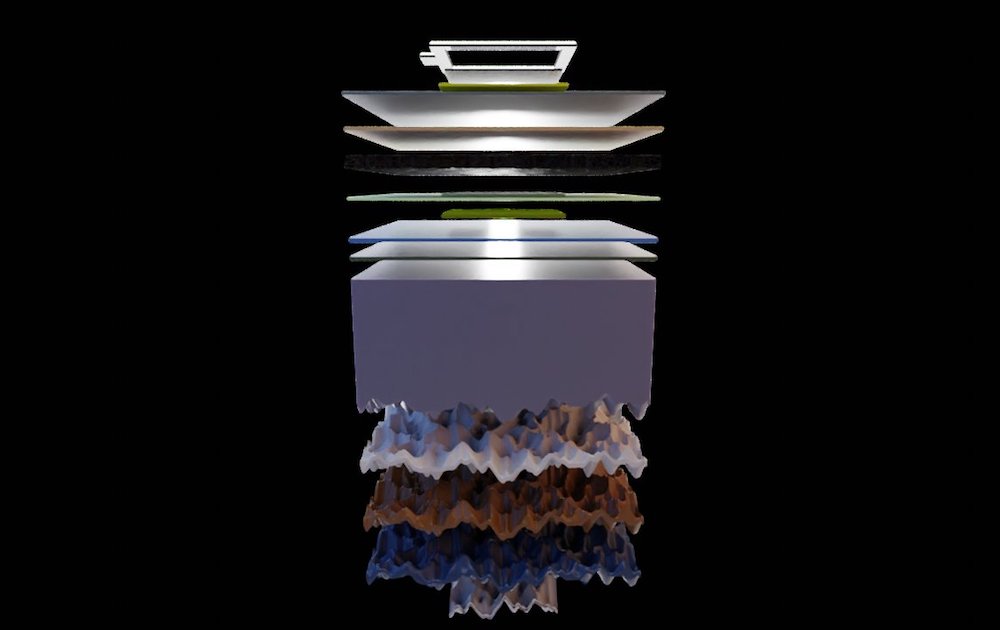
[Image above] An illustration of the perovskite/silicon tandem solar cell that achieved 29.15% power conversion efficiency. Credit: Eike Köhnen, Helmholtz Zentrum Berlin
In January this year, the efficiency of perovskite/silicon tandem solar cells reached another milestone when researchers at Helmholtz Zentrum Berlin in Germany announced they achieved 29.15% power conversion efficiency, beating the previous record of 28.0% (Oxford PV).
The Fraunhofer Institute for Solar Energy Systems certified the value, and NREL listed it in its chart that tracks the rising efficiency levels for nearly all types of solar cells. However, the researchers at that point did not release details of the process used to create the record-setting cells. That changed last week with the publication of a paper in Science detailing fabrication and testing of the tandem solar cells.
How to create tandem solar cells with more than 29% efficiency
In the paper’s introduction, the researchers explain that achieving high-efficiency tandem solar cells requires using perovskite compositions with a wider bandgap. Unfortunately, to date such cells experience considerable open-circuit voltage losses, i.e., a loss in the maximum voltage available from the cell.
The main reasons for this loss include comparably low photoluminescence quantum yields of the absorber material itself, an unsuitable choice of selective contacts, and phase instabilities. The researchers addressed these issues by creating a solar cell with an improved charge extraction efficiency.
Charge extraction efficiency refers to how well charge can be extracted from a solar cell. In general, the extraction process involves charge carriers diffusing through the cell to a special charge extraction layer, where extraction of the charge takes place.
In the case of perovskite/silicon tandem solar cells, “we observed that the extraction of holes is much slower than electron extraction, which limited the fill factor [ratio of the actual maximum obtainable power],” first author and Ph.D. researcher Amran Al-Ashouri says in a Helmholtz Zentrum Berlin press release. Thus, to improve the obtainable power, they needed to make the hole extraction process occur faster.
To speed up the extraction process, the researchers designed a new charge extraction layer made from a self-assembled monolayer created via methyl group substitution. According to the researchers, the self-assembled monolayer provided both fast extraction and efficient passivation at the hole-selective interface, a combination that addressed the main issues limiting power conversion efficiency. Specifically, it slowed light-induced halide segregation of the perovskite, allowed a photoluminescence quantum yield as high as on quartz glass, and led to high single-junction device open-circuit voltage values of more than 1.23 V.
Fortunately, “The single-junction improvements transferred into tandem devices, which allowed us to fabricate perovskite/silicon tandem solar cells with a certified [power conversion efficiency] of 29.15%,” the researchers write. “This value surpasses the best silicon single-junction cell (26.7%) and is comparable to the best GaAs solar cell at the same area of 1 cm2.”
In tests, the researchers found their tandem solar cell retained 95% of its initial efficiency after 300 hours in ambient air without encapsulation.
In the conclusion, the researchers suggest that, based on analysis of the individual subcell current-voltage curves, they could in principle realize power conversion efficiency values of up to 32.4% if the tandem device design featured only a standard perovskite film without additional bulk passivation.
“Decreasing the limitations set by the hole extraction speed, as shown in this work, is a viable path for exploring this potential,” they write.
The paper, published in Science, is “Monolithic perovskite/silicon tandem solar cell with >29% efficiency by enhanced hole extraction” (DOI: 10.1126/science.abd4016).
Author
Lisa McDonald
CTT Categories
- Energy
- Material Innovations
Related Posts
‘Fairy circles’ may help mark natural underground hydrogen deposits
September 18, 2025


